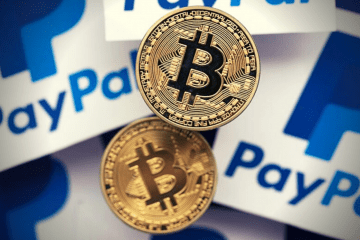Is bitcoin going mainstream?
The cryptocurrency suffers from all the problems it has always had and that may never change. But digital currencies more broadly may be about to take off.
How is bitcoin getting on?
By its own standards, bitcoin has achieved a certain stability, in that its price in recent weeks – in the range of $7,000 to $9,000 – is in the same ball park as it was 12 months ago. Bitcoin remains highly volatile: its price all but halved between mid-February and mid-March (as financial markets took fright at Covid-19), before running back up again strongly since then. It remains primarily a tool for speculators, rather than a means of exchange or store of value. Yet the cryptocurrency has nevertheless defied predictions – following the popped bubble of 2017 – that it would collapse, or become near-worthless. The crash was spectacular and several other cryptocurrencies fell even more steeply (over 90% falls). But one bitcoin remains around half the value of the all-time peak (near $20,000) in December 2017. It bottomed out a year later, at around $3,200 – and in the year and a half since then it’s been on a rising trend, which bitcoin boosters hope will get an extra lift from the imminent “bitcoin halving”.
What’s a bitcoin halving?
A halving of the rate at which new bitcoins are created, by making them harder to mine. At some point in the next few days (either Monday or Tuesday) the 18,375,000th bitcoin will be generated by its decentralised community of digital miners, after which the rewards for miners producing bitcoin will be cut in half – making it twice as difficult (and twice as energy-intensive) to produce new bitcoins. This halving (or “halvening” to some crypto-purists) takes place about every four years: previous halvings took place in 2012 and 2016, and the process is a key part of the mathematical code underpinning the bitcoin project.
What’s its purpose?
Part of what makes bitcoin distinctive, and underpins its claim to credibility as a store of value, is its cap on supply: only 21 million bitcoins can ever be created, and more than 18.3 million of these have already been mined. The halving process is built into this model as a way of promoting the system’s viability by ensuring scarcity and curbing runaway inflation. Bitcoin works by using powerful computers to verify each block of blockchain transactions every ten minutes or so. When bitcoin was launched, the “block reward” for verifying each block was set at 50 bitcoins, but every 210,000 blocks, that reward is halved. This latest halving will take the reward down from 12.5 to 6.25 bitcoins – meaning that lots of miners will shut up shop, since it will no longer be profitable for them to mine the cryptocurrency.
Why might this boost the price?
There’s no special reason why it should, other than increased scarcity – and that ought to be priced in well in advance, since the halving has been known about for years. But the bitcoin market is not known for cool rationality and bitcoin boosters look back lovingly at previous halvings. The first presaged a 100-fold rise in the price from about $10 in late 2012 to about $1,000 a year later. The second, in July 2016, came when the price had eased back to about $650 – but over the following 18 months it rocketed to almost $20,000. The ultimate bitcoin booster is the former Goldman Sachs hedge-fund manager Raoul Pal, who argues that the price of one bitcoin could reach $1m (a further 100-fold rise) before the next halving event in 2024. In his April report for his Global Macro Investor service, Pal argues that bitcoin will become a safe-haven asset. “Gold is the protection of our assets. Bitcoin is the call option on the future system. Both are going to save us and probably make us rich,” he says.
Is that plausible?
It would certainly imply a total paradigm shift from the scepticism with which cryptocurrencies are regarded by many institutional investors. Some analysts suspect the vast post-Covid fiscal stimulus could be the inflationary spark that sets off such a shift. “If we get a pickup in inflation, bitcoin’s price will become unhinged,” reckons Clem Chambers in Forbes. Yet the core problems with cryptocurrencies are well known and haven’t changed. The technology is too clunky and energy-intensive to operate at scale, and the sector is riddled with fraud and incompetence – and of most use to organised criminals. Since transactions are irreversible, Ponzi schemes and cons are ten a penny, and cryptocurrency exchanges often collapse or get hacked. For all these reasons, most commentators don’t see cryptocurrencies entering the mainstream.
What about digital money more broadly?
Proponents argue that the Covid-19 emergency has highlighted the usefulness of cryptocurrencies. But it has also demonstrated the enduring power of the state – and recent months have seen two developments that suggest the future may belong more to state-backed digital currencies than to bitcoin and its ilk. First, last month Facebook unveiled its revamped proposal for its transnational Libra currency. The new version is much less like bitcoin and much more conventional: it has abandoned the distinctive open architecture of cryptocurrencies and is instead more like a traditional payment network in which coins will be tied to a local currency, a bit like the digital dollars in a PayPal account.
And the other development?
Second, partly spurred by Libra, several countries – in particular China – have accelerated plans for their own digital currencies. China began work on its plans for the world’s first “central-bank digital currency” in 2014 and has just begun a pilot scheme in collaboration with the country’s four biggest commercial banks. Some expect the digital yuan to be launched later this year – a potential landmark in the story of digital currencies. A digital yuan is expected to give Chinese authorities the power to track digital cash, cut tax avoidance and precision-tool monetary policy. What it definitely won’t be is a beacon of decentralised, permissionless control and fiat-free liberty.
Source: moneyweek.com


